

|
Jennifer Patton / Jacob Criswell | Spring 2001 |
| History 1302 | Hines |
(Click Pictures To Enlarge)
 When an idea has passion, it
turns into reality. Towns, businesses, schools, and even dream-houses were once
an idea, but then blossomed into a physical accomplishment.
When an idea has passion, it
turns into reality. Towns, businesses, schools, and even dream-houses were once
an idea, but then blossomed into a physical accomplishment.
Along the Atascosa River a total 15 grants of 14,000
acres per grant by the Mexican Government; Colonel José Antonio Navarro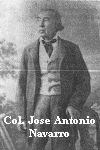 in 1828. Navarro helped in
organizing the Texas Republic government and was one of the signers of the Texas
Declaration of Independence in 1836. He was the first Bexar District
representative to the Texas State government. In 1856 Navarro helped in
establishing the organization of Atascosa County and also, gave land for the
first courthouse and for the town of Atascosa County. Col. Navarro was head of
the expedition to Santa Fe that studied territories in west Texas.
Many Texas histories cover this story of this expedition and the notable courage of
Colonel José Antonio Navarro.
in 1828. Navarro helped in
organizing the Texas Republic government and was one of the signers of the Texas
Declaration of Independence in 1836. He was the first Bexar District
representative to the Texas State government. In 1856 Navarro helped in
establishing the organization of Atascosa County and also, gave land for the
first courthouse and for the town of Atascosa County. Col. Navarro was head of
the expedition to Santa Fe that studied territories in west Texas.
Many Texas histories cover this story of this expedition and the notable courage of
Colonel José Antonio Navarro.
One special idea from blueprints turned into what is known today as the town of Jourdanton, Texas.
Jourdanton, is the present county seat of Atascosa County. Jourdan Campbell, for which the town is named, founded it in
September 1909. Even though Jourdan Campbell
Jourdan Campbell, for which the town is named, founded it in
September 1909. Even though Jourdan Campbell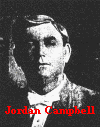 founded Jourdanton, the man
never lived in Jourdanton. His home was in Campbellton, Texas, where he and his
family are buried. Campbell and his partner, Col. T. H. Zanderson, owned
40,000 acres, which is known as The Toby Ranch.
founded Jourdanton, the man
never lived in Jourdanton. His home was in Campbellton, Texas, where he and his
family are buried. Campbell and his partner, Col. T. H. Zanderson, owned
40,000 acres, which is known as The Toby Ranch.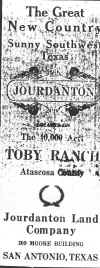 This ranch joins with the town of Jourdanton. From blueprints to laying out
the town, Captain C. S. Young is credited for the work. The whole idea of Jourdanton being
built was to bring in the Artesian Belt Railroad to the Jourdanton area. The
town paid a $50,000 bonus to the railroad company to insure that the Belt would
come through the Jourdanton area.
This ranch joins with the town of Jourdanton. From blueprints to laying out
the town, Captain C. S. Young is credited for the work. The whole idea of Jourdanton being
built was to bring in the Artesian Belt Railroad to the Jourdanton area. The
town paid a $50,000 bonus to the railroad company to insure that the Belt would
come through the Jourdanton area.
Loads of building materials were rolling into town and overnight, it seemed,
businesses and home structures were being built. On a Thursday, Friday, and Saturday in 1909 a large auction sale was scheduled to auction off lots and
acres of land to make the site of Jourdanton become a real town. Some
festivities during the three-day sale were barbeques, dances every night, a bronc
busting exhibition, and an Old Fiddler's Contest which offered a $25.00 prize. At
the time of the three-day auction, Mr. Peter F. Watson  of
Jourdanton Land Company was offering to sell land at $15.00 an acre. By 1910 W.
M. O’Brien offered land two miles from the town site for sale at $20.00 an
acre. As you can see, as the years went on, the price of land per acre increased.
Because the soil was so fertile, the area produced an abundance of cotton.
Hogs were a source of livestock that was raised in great quantities. The hogs
were shipped or sent by railroad, along with the baled cotton, to the San Antonio
markets. The Steinle Brothers Gin operated a daily production of fifty bales.
of
Jourdanton Land Company was offering to sell land at $15.00 an acre. By 1910 W.
M. O’Brien offered land two miles from the town site for sale at $20.00 an
acre. As you can see, as the years went on, the price of land per acre increased.
Because the soil was so fertile, the area produced an abundance of cotton.
Hogs were a source of livestock that was raised in great quantities. The hogs
were shipped or sent by railroad, along with the baled cotton, to the San Antonio
markets. The Steinle Brothers Gin operated a daily production of fifty bales.
In 1909, the Atascosa County State Bank was already doing business. The bank brought in about $50,000. By 1910 the
two-story brick building holding the bank was finished. This bank was located on
Main Street in Jourdanton. It was around 1909 that the Monitor Newspaper was
moved to Jourdanton from the nearest town, Pleasanton, Texas. The newspaper was
located in what is today as the VWF Hall
was already doing business. The bank brought in about $50,000. By 1910 the
two-story brick building holding the bank was finished. This bank was located on
Main Street in Jourdanton. It was around 1909 that the Monitor Newspaper was
moved to Jourdanton from the nearest town, Pleasanton, Texas. The newspaper was
located in what is today as the VWF Hall![]() on Highway 97 in Jourdanton. The founder of the Monitor was Mr. Dan Ernst. Now
the Pleasanton Express serves Jourdanton and Atascosa County. Two churches were
established in the Jourdanton during this time period. The Methodist Church
on Highway 97 in Jourdanton. The founder of the Monitor was Mr. Dan Ernst. Now
the Pleasanton Express serves Jourdanton and Atascosa County. Two churches were
established in the Jourdanton during this time period. The Methodist Church was organized in 1909. The
original Methodist Church was held in a tent across the street from the present
day church location. The other church was the Baptist Church,
was organized in 1909. The
original Methodist Church was held in a tent across the street from the present
day church location. The other church was the Baptist Church, in 1909, which was organized
into the Rio Grande Association. The first church building was built in 1910 at
its location at Quality Ridge.
in 1909, which was organized
into the Rio Grande Association. The first church building was built in 1910 at
its location at Quality Ridge.
Like in every town that is maturing, there is violence. One of the local ladies
was willing to pay a reward of $300 to anyone who saw to it
that a cattle thief was caught with any of her cattle was convicted and placed
in jail. In some cases, rewards were not offered, but a little bit of a “Necktie
Party” was planned; which was a lynching. Over the years the law
and order has changed. Jourdanton still has the old red brick jailhouse that is
standing in the middle of town. The jail was a 12-foot hole in the ground,
roofed over, and has a padlock trap door. In 1893, a brick jail was built North
of the courthouse in Pleasanton, just five miles east of Jourdanton. With the exection by hanging of Porferio Torres on April 19,1914; the death penalty has
only been carried out twice in this county. The Pleasanton jail was torn down in 1953.
The county jail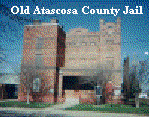
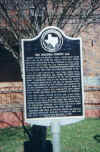 in Jourdanton was built and
designed by H.T. Phelps and was completed in 1915. The red brick jail was not
used after 1982 when the new jailhouse was built and just a few blocks south of the
old brick jailhouse. This jail was more modern and efficient than the old one,
it was much like the ones in the bigger cities.
in Jourdanton was built and
designed by H.T. Phelps and was completed in 1915. The red brick jail was not
used after 1982 when the new jailhouse was built and just a few blocks south of the
old brick jailhouse. This jail was more modern and efficient than the old one,
it was much like the ones in the bigger cities.
Some of Jourdanton’s natural resources are oil. In Atascosa County oil is number one as a mineral. It was discovered in 1917. The Humble Oil Company, in 1942, moved in and was the first company to catch people’s eye. Today there are many oil companies drilling in the Jourdanton and Atascosa County area. Another resource was sand. Large quantities of sand were being shipped in 1914 to San Antonio and other parts of Texas. Glass and masonry work was made from the excellent quality sand. Ninety percent of the sand exported was sent to San Antonio and other parts of the United States, as well as Mexico. In 1911 a brick factory was opened in the northern part of Jourdanton. The factory produced a good grade of brick until a bigger brick company bought them out to eliminate competition with in the industry. The Beef Cattle Company was the major enterprise in and around the Jourdanton area and is increasing everyday. Dairy cattle are another major enterprise. In 1911 the Central Drug store in Jourdanton developed a screw worm medicine. This product is known as Peerless worm killer and has been used throughout the United States and other countries where screw worms infest livestock.
In 1932 the Charlotte-Jourdanton highway was built and later this connected with the old highway number nine at Pleasanton which was built in the earlier years. During this era of road building, the farm roads were improved and practically all streams were bridged. In 1940 there were 70 miles of hard surfaced roads within the boundaries of Atascosa County. In 1951 there was 285 miles of hard surfaced roads, and laterals leading into the highways were greatly improved. In 1951 plans were underway to hard surface 25 more miles of road.
In 1948, according to the tax collectors records, approximately 6,000 motor vehicles traveled the highways and road systems within the county to provide transportation for the 20,000 inhabitants. Three railroad lines, Missouri Pacific System lines ran from San Antonio to Poteet to Jourdanton, served the county.
Jourdanton Independent School District was established in 1909. The wooden frame building was located in the western
part of town. If it were still here today it would be located in the area of the
log cabin on Highway 97. The school faced east towards Campbell Street. At the
time the school was established it was known as the Hilburn School. In 1909 the
school had over 100 students enrolled and had three teachers and accommodated
all 12 grades. In 1910 the number of students had grown so much due to population growth
a larger school was needed, so the old one was torn down. In 1950 Jourdanton ISD was composed of 95 square
miles, which is about 59,800 acres. At this time only 22 teachers were
teaching over 435 students.
was established in 1909. The wooden frame building was located in the western
part of town. If it were still here today it would be located in the area of the
log cabin on Highway 97. The school faced east towards Campbell Street. At the
time the school was established it was known as the Hilburn School. In 1909 the
school had over 100 students enrolled and had three teachers and accommodated
all 12 grades. In 1910 the number of students had grown so much due to population growth
a larger school was needed, so the old one was torn down. In 1950 Jourdanton ISD was composed of 95 square
miles, which is about 59,800 acres. At this time only 22 teachers were
teaching over 435 students.
After researching Jourdanton, Texas, I have realized that something so small can develop into such a successful town. Due to technology, many of the companies that I discussed have been replaced. I believe that Jourdanton will grow and grow just like any other town that is still young.
INTERVIEWS:
What kind of environment would you say that Jourdanton has?
TIM CHALLES: “I would say that Jourdanton has a quiet environment that makes a family feel secure and comfortable.”
Has anyone ever told you the history of Jourdanton?
TINA GARZA: “No, but I have read some books that talk about Jourdanton, on how cattle played a major role on the expansion of the town.”
Do you know how Jourdanton was established?
LAURA CRISWELL: “Yes, my grandmother told me that Jourdanton was built there to make sure that railroad companies would travel and trade through there. It did not take long for the town to boom into action with other towns. I was really interested in it when she talked about the hangings and how things were handled when there was a crime committed.”
Why did you move from Jourdanton?
TIM CHALLES: “I moved from Jourdanton because of new job opportunities and plus, I got married.”
LAURA CRISWELL: “I got married and was looking to expand my horizons.”

ANNOTATED BIBLIOGRAPHY:
1. About Jourdanton, Texas. (1986). Texas: Jourdanton. *It had resources mentioned.
2. Atascosa County Centennial Association. 1856-1956 Atascosa City, TX. October 3,4,5, and 6. Published 1956. *Talked about who founded Jourdanton.
3. Texas Sesquentinial 1836-1986
4. Jourdanton Community Library. 1220 Simmons Jourdanton, TX 78026
5. www.MAPQUEST.com *Map of Jourdanton, TX.
6. The Handbook of Texas Online. http:////www.tsha.utexas.edu/handbook/online/articlues/view/JJ/hgj4.html
*Helped to find out who, why, and when Jourdanton was established.
7. Interview: Laura Criswell. March 15,2001. Past resident and attended Jourdanton High School.
8. Interview: Tim Challes. March 15,2001. Past resident of Jourdanton, Texas.
9. Interview: Tina Garza. March 18,2001. Resident of Jourdanton, Texas.
10. Jourdanton City Hall. Jourdanton, Texas. *Picture of Jose Antonio Navarro.